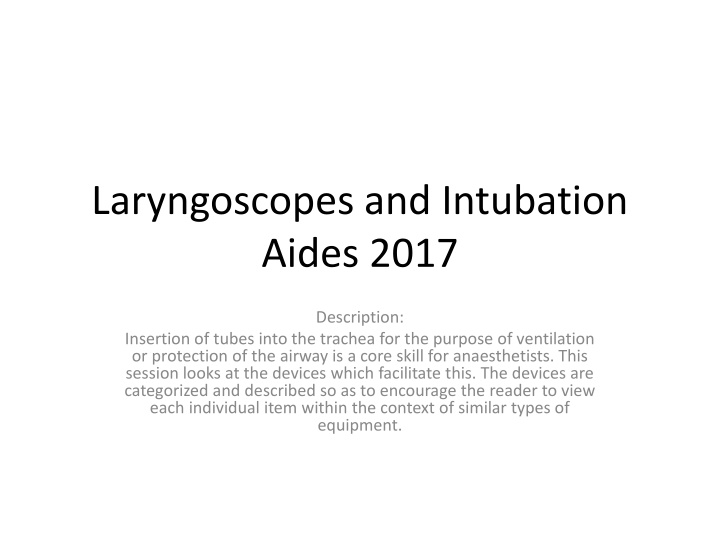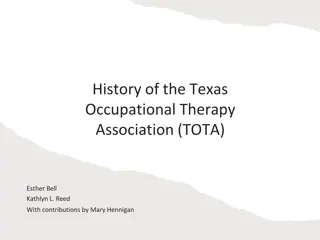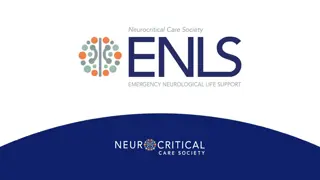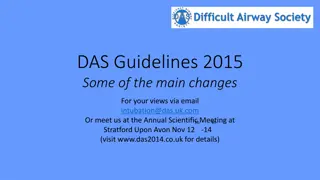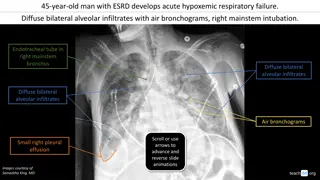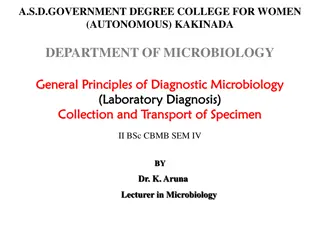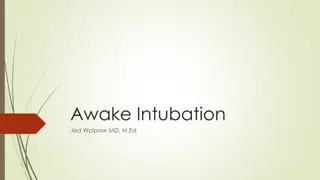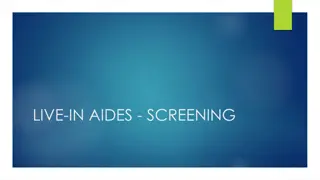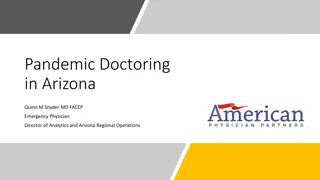Core Skills in Laryngoscopes & Intubation Aides
Insertion of tubes into the trachea is a crucial skill for anaesthetists. Learn about laryngoscopes, their types, designs, and functions. Understand how intubation aids assist in tube insertion. Explore rigid retractor and optical laryngoscope models.
Download Presentation

Please find below an Image/Link to download the presentation.
The content on the website is provided AS IS for your information and personal use only. It may not be sold, licensed, or shared on other websites without obtaining consent from the author.If you encounter any issues during the download, it is possible that the publisher has removed the file from their server.
You are allowed to download the files provided on this website for personal or commercial use, subject to the condition that they are used lawfully. All files are the property of their respective owners.
The content on the website is provided AS IS for your information and personal use only. It may not be sold, licensed, or shared on other websites without obtaining consent from the author.
E N D
Presentation Transcript
Laryngoscopes and Intubation Aides 2017 Description: Insertion of tubes into the trachea for the purpose of ventilation or protection of the airway is a core skill for anaesthetists. This session looks at the devices which facilitate this. The devices are categorized and described so as to encourage the reader to view each individual item within the context of similar types of equipment.
Session Introduction Learning Objectives: By the end of this session you should be able to: Identify the types of laryngoscopes most commonly used in anaesthetics Describe the design of both rigid retractor type and optical models of laryngoscope Explain the application and limitations of both rigid retractor and flexible models of laryngoscope Identify intubation aids commonly used in anaesthetics Describe the specific functions for which the several intubation aids are designed
Introduction Laryngoscopes are used in anaesthesia in order to visualize the larynx and to allow the insertion of tubes into the trachea. This session will describe the design and function of these devices, which can broadly be divided into two categories: Rigid lighted retractors: The device more traditionally recognized as a laryngoscope falls into this group. These devices function primarily by retracting the tissues of the oropharynx to provide an unimpeded line of sight, allowing the alignment of the anesthetist's eye and the target area
Introduction Optical devices: In cases where a direct line of sight is not possible, a device is needed that allows the anaesthetist to look around corners by conveying the image visible from the tip of the device along a constructed optical pathway. Flexible fibre - optic scopes and rigid optical models will be described Intubation aids are a disparate group of relatively simple devices designed to assist in the process of inserting a tube into the trachea with or without the associated use of a laryngoscope. The session will cover the most commonly used examples of these aids.
Rigid Lighted Retractor Laryngoscopes The basic design The basic laryngoscope design, it consists of a handle which also houses the batteries to power the light source. A detachable laryngoscope blade hooks onto the handle. In older models the light bulb is located on the blade of the laryngoscope. More recent designs incorporate the light source in the handle and use a fibre optic bundle to convey the light to the tip of the blade. Disposable and single use versions use a Perspex rod for this purpose. Opening the blade turns the light on by forcing the bulb down to contact the battery terminal. Examples of this group of laryngoscopes usually take their name from the design of the retractor blade used on the device, such as the Macintosh design. In contrast with optical laryngoscopes, the image quality obtained with this basic design is determined by the anesthetist's eyesight and the brightness of the light source.
Rigid Lighted Retractor Laryngoscopes Other designs There are many designs of laryngoscope blade, as can be seen in Fig 1. The Macintosh laryngoscope blades, shown in the top left of the picture, are by far the most commonly used: almost to the exclusion of all others. The majority of patients can easily be intubated with this device. Although different blade designs will possibly give better views of the larynx under some circumstances, it is not practicable for an individual anaesthetist to be adept at all the techniques required. It is far more appropriate to be experienced with one device. Key to Fig 1: A. Macintosh Pattern: Large Adult, Adult, Infant B. Seward Pattern: Child, Infant C. Miller Pattern: Large Adult, Adult, Child, Infant, Neonate D. Polio Pattern: Adult E. Macintosh Left Hand Pattern: Adult F. Oxford Pattern: Infant G. Robertshaw Pattern: Infant, Neonate H. Wisconsin Pattern: Infant, Neonate
Key to Fig 1: A. Macintosh Pattern: Large Adult, Adult, Infant B. Seward Pattern: Child, Infant C. Miller Pattern: Large Adult, Adult, Child, Infant, Neonate D. Polio Pattern: Adult E. Macintosh Left Hand Pattern: Adult F. Oxford Pattern: Infant G. Robertshaw Pattern: Infant, Neonate H. Wisconsin Pattern: Infant, Neonate
The Macintosh laryngoscope To allow maximal mouth opening and to assist in aligning the axes of the airway, the patient s head is raised onto the pillow and tilted back as if sniffing the morning air (compare Figs 1a and 1b). The Macintosh laryngoscope is inserted into the mouth such that the tongue is swept to the left. For effective laryngoscopy, the tip of the blade must be brought to lie firmly in the vallecula, so that lifting the laryngoscope in the direction of the handle may lift the epiglottis off the posterior pharyngeal wall and up out of the line of sight to reveal the larynx below. Note that tongue base and floor of mouth are retracted by the body of the laryngoscope blade into the space bound laterally by the bony mandible.
The Flexible Fibre Optic Scope Flexible fibre optic scopes (FFS) can follow the anatomical airway, more or less irrespective of its shape. The FFS is so named because it transmits an image from the tip of the device to the eyepiece via a flexible glass fibre optic bundle which is encased in a series of flexible coverings.
Intubation Aids Overview These devices, variously known as bougies, stylets and guides are used to steer tubes into a trachea that has been located by: Sight Inference from the position of other anatomical structures, e.g. the epiglottis or arytenoid cartilages or An existing tracheal tube In this section we shall consider : The gum elastic bougie (GEB) Stylets The Aintree Intubation Catheter The airway exchange catheter (AEC) Light wands and the Trachlight
Intubation Aids Gum elastic bougie (GEB) The gum elastic bougie (GEB), originally the Eschmann tracheal introducer, is a soft malleable device which, in combination with a standard rigid laryngoscope such as the Macintosh, can manage most intubations, even when the larynx is not directly visible. The bougie material has a good memory for holding any shape into which it is bent whilst still being soft enough to be relatively atraumatic to the delicate tissues of the airway. Single use versions exist but these may not have the same characteristics as the traditional GEB in terms of memory or stiffness. They are inserted into the trachea, held in place and then a tube is threaded onto the bougie and passed over it and into the trachea.
Stylets Intubation Aids In contrast to the GEB, stylets tend to be much more rigid, being composed of a metal core that is covered in plastic. The stylet is inserted into the tracheal tube to shape it before attempting intubation.
Intubation Catheters Intubation Catheters The Aintree intubation catheter, shown in Fig 1, is designed to be used with a fibrescope being passed through an LMA or other supraglottic airway, as described on page 7. It allows any appropriate size of tracheal tube to be inserted into the trachea which would otherwise be limited by the size of tube that could be passed through the supraglottic airway.
Intubation Catheters The airway exchange catheter (AEC) The airway exchange catheter (AEC) is a long hollow tube that can be inserted through a tracheal tube (TT), allowing the tracheal tube to be withdrawn and another inserted over it. In cases where the patency of the patient s own airway is in doubt, such as following extensive head and neck surgery, the AEC can be left in situ when the TT is removed. Its small diameter in comparison to the TT tube, and soft texture make it well tolerated by the patient when awake. If all is well after a period of time, the AEC can then be removed too. However, if there is airway collapse and respiratory distress, the patient may be temporarily oxygenated via the AEC. For this purpose, specially designed detachable 15mm male taper fit and Luer-Lok connectors are provided. The patient can then be easily re-intubated by passing an TT tube over the catheter once the connector is removed.
Light Wands And The Trachlight Transillumination of the thyroid cartilage/laryngeal inlet and trachea can also be used to aid intubation. A light wand is simply a malleable long stylet with a light source at its distal end. This concept is further developed in the Trachlight. This is a preformed stylet with small light source at the tip, as shown in Fig 1. The Trachlight carries a TT tube off a specially designed handle and into the trachea once the transillumination is seen in the midline of the neck. In skilled hands this low-tech device is remarkably effective in the right circumstances.
Retrograde Intubation Another low-tech approach that is rarely remembered but highly effective is that of retrograde intubation . Where the trachea can be palpated in the neck, it may be punctured by a needle and then a soft guide wire can be passed up to emerge through the mouth or nose. Inserting a stiffener over the wire from above allows a tracheal tube to follow the wire more easily without displacing the wire or causing it to kink. Retrograde intubation may be particularly indicated in scenarios where ordinary laryngoscopy fails to provide a view and there is blood or debris in the airway. Specially designed retrograde intubation kits are widely available, and an example is shown in Fig 1. Their component parts fit together easily to make them quick and easy to use when needed.
Session Key Points Laryngoscopes are used in order to visualize and locate the laryngeal inlet to allow insertion of tubes Traditional laryngoscopes are rigid lighted retractors to allow alignment of eye and target area Where it is not possible to attain that for anatomical or pathological reasons, a device is needed that allows the anaesthetist to look around corners by conveying the image visible from the tip of the device Flexible fiber optic scopes can follow the anatomical airway more or less irrespective of the shape Rigid optical scopes can convey the image around corners but they have a fixed shape which is a limitation. They however, also work as tissue retractors. It is yet not clear where and how they fit into the anaesthetists repertoire Bougies, stylets and guides are used to steer a tube into a trachea that has been located by sight, by inference or by an existing trachea tube The Aintree catheter in combination with FFS allows use of a cLMA as a conduit and is a simple and powerful technique
Session Summary Learning Objectives Identify the types of laryngoscopes most commonly used in anaesthetics Describe the design of both rigid retractor type and optical models of laryngoscope Explain the application and limitations of both rigid retractor and flexible models of laryngoscope Identify intubation aids commonly used in anaesthetics Describe the specific functions for which the several intubation aids are designed
